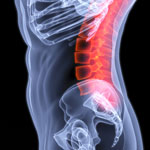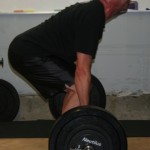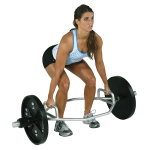Brian Schiff’s Blog
Injury Prevention, Sports Rehab & Performance Training Expert
I have had the pleasure of authoring a bi-weekly column for PFP’s online magazine entitled “Functionally Fit” for over three years now. This column gives me a creative avenue to display my specific training techniques and teach others how to build a better functional body in the process.
One of the greatest things about exercise is all the different options, variations and tweaks available to bring about a desired physical change in the human body. As Alwyn Cosgrove once said, “Exercise is like medicine.” By this, he means the right dosage and application is critical. I could not agree more.
As training and rehab continue to evolve and become even more intertwined, we as practitioners need to continue seeking ways to get more from our exercises. I personally use lots of different training tools in my trade, but I am always seeking to get the biggest return on my exercise investments. Today, I am sharing one such exercise with you, the 3D Mountain Climber with Hip Extension. Check out the video below:
In this video, I am working to improve shoulder, hip and core stability as well as strongly encourage hip disassociation. Many clients I train and rehab simply are asymmetrical or cannot disassociate their hips which leads to flawed movement patterns and leaks int he kinetic chain.
I used this exercise in our core training series we were doing with the Carolina Hurricanes in their pre-season conditioning sessions that we just recently completed. It is not easy, but delivers so much benefit for just one movement. In the video I display a BOSU balance trainer, but in my online column for PFP, I include a full buildup progression as well. Click here to read the column.
I think it is safe to say most would agree that deadlifts are great for building maximal lower body strength. Elite Olympic weightlifters are generally able to lift more loads in this lift compared to other free weight exercises. I know personally that I like to use it to develop lumbar extensor strength, as well as in place of the squat if I want to avoid spinal compression from the weight of the bar.
In the past I have heard some strength coaches say they don’t use a hex bar for deadlifts because it is not the same as lifting a straight bar. While not always sure exactly what they mean by that, I found a recent article in the July 2011 Journal of Strength & Conditioning Research very insightful. The researchers looked at the difference between straight and hexagonal bar deadlifts in submax loading situations.
The concern with deadlifting has always been stress on the spine. The study notes:
“For world class athletes lifting extremely heavy loads, lumbar disk compression forces as large as 36,400 N have been reported.”
Lifters have long been encouraged to keep the barbell as close to them as possible to reduce the moment arm. The issue with the straight bar is that it can impinge on the body. Thus, the trap bar or hex bar apparatus was developed. The researchers hypothesized that the hex bar would reduce the joint movements and resistance moment arms. In addition, they hypothesized that larger forces would be produced with the submax loads.
The study use 19 male powerlifters and was conducted 3 months after their most recent competition where most were at the end of a training cycle aimed at matching or exceeding their previous competition performance. The subjects (following their own warm-up) performed HBD and SBD at 10, 20, 30, 40, 50, 60, 70 and 80% of his SBD 1RM. Twelve markers were placed on the body for biomechanical analysis.
Today I am going to share two pieces I have written for other publications as I think the exercises I discuss have real merit and broad application for competitive athletes and weekend warriors. I am a columnist for PFP Magazine and Endurance Magazine and these articles come from those publications.
Single Leg Theraband Activation Squats
The idea behind this exercise is applying progressive gradients of resistance that encourage the faulty motion (pulling the leg into adduction and internal rotation) to facilitate increased activation of the gluteus medius/minimus and small lateral rotators to create an anti-adduction/internal rotation force. Decreasing such moments at the knee will reduce IT Band issues, patellofemoral pain, ACL injury risk and overuse problems often seen in running.
Click here to see how to perform the exercise
Mobility Training for Endurance Athletes
It is no secret that endurance events require repetitive motion and often carry a higher risk of overuse injuries. In light of this, poor thoracic extension and/or limited ankle dorsiflexion negatively impact proper running and riding mechanics and lead to faulty movement patterns. Beyond physical stress, this reduces performance capacity as well. There are two simple mobility exercises to help correct imbalances that may be hindering you.
Click here (go to page 16) to see how to sustain your body with these exercises
ACL injuries continue to proliferate among female athletes. I am passionate about preventing them, and part of my professional mission is to study and evolve in my rehab and prevention training approaches all the time to stay on top. I wanted to pass along some new information on a new screening tool just unveiled in the Strength and Conditioning Journal this month.
Before I reveal the screening and training tool, I want to take a moment and review what Timothy Hewett refers to as modifiable risk factors that contribute to injury risk based on his work:
- Ligament Dominance – defined as an imbalance b/w neuromuscular and ligamentous control of dynamic knee stability and it is visualized by loss of frontal plane control with landing and cutting
- Quadriceps Dominance – defined as an imbalance between quad and hamstring strength, recruitment and coordination
- Leg Dominance – defined as an imbalance between the two legs with respect to strength, coordination and control
- Trunk Dominance ‘Core’ Dysfunction – defined as an imbalance b/w the inertial demands on the trunk and its ability to resist or control/resist it
Previously, Hewett has identified that high knee abduction moments are related to high LOAD on the knee and a major risk factor for ACL injury. He and his colleagues have done extensive motion analysis in their lab in Cincinnati, OH. As such, a drop landing test has been used as one tool to observe landing mechanics and assign some risk value to athletes competing in cutting and jumping sports.
In the current article (click here for the abstract) Meyer, Brent, Ford and Hewett unveil a new screening tool involving the tuck jump. They propose that this tool is easier for the S & C coaches to do on the field and not only assess risk factors by way of observing technical flaws, but also use the tool as a training maneuver.
The idea is the subject will perform tuck jumps for 10 seconds consecutively while the observer makes notes on the following pre, mid and post jumping:
- Lower extremity valgus at landing
- Thighs do not reach parallel (peak height of jump)
- Thighs not equal side-to-side (during flight)
- Foot placement not shoulder width apart
- Foot placement not parallel (front to back)
- Foot contact timing not equal
- Excessive landing contact noise
- Pause b/w jumps
- Technique declines prior to 10 seconds
- Does not land in same footprint (excessive in flight motion)
Factors 1-3 refer to knee and thigh motion, 4-7 refer to foot position during landing and 8-10 refer to plyometric technique. Coaches are instructed to grade the flaws if seen with check marks during the phases they are seen and use this as a guide for correction. They may also use cameras in the frontal and sagittal plane to assist them.
My thoughts on this are:
- There is sound science behind the rationale for the test and modifiable risk factors
- There is a need for basic no-cost screening tools coaches can apply in their settings
- The tuck jump assessment will provide instant feedback on form and identify technical flaws that may indicate higher risk for injury
- The tuck jump is a higher demand plyo drill so I fear poor form may be as much to blame on inexperience and unrefined motor patterns as it is to just dominance patterns so we need to keep plyo training experience in mind when analyzing the screen results especially for beginners
- The tuck jump assessment does not really consider fundamental movement restrictions that may bias the form on one side if an asymmetry is present
- I still wonder how much ankle pronation impacts landing and whether we will see more research on this – there was a study done at ECU where they used orthotics and saw a reduction in ACL tears in their collegiate athletes so I have to wonder about this crucial element of the kinetic chain
In the end, we still lack many answers. According to data published in the Journal of Athletic Training in 2006, non targeted neuromuscular training programs need to be applied to 89 female athletes to prevent 1 ACL tear. So, we need to keep studying and applying science to our training, all the while critically questioning science and looking at our athletes holistically to find the best prevention strategies for each one individually and for at risk athletes as a whole.
Often, people assume hip and knee pain begin and end in those respective joints. While this can be the case, the truth is the ankle may also have a say in the matter. In my practice, I often see gait deviations, IT band issues, patellofemoral pain and many other issues related to ankle stiffness or soleus issues.
In assessing athletes, runners and weekend warriors, I often pick up asymmetries when measuring closed chain ankle dorsiflexion. I have even observed people who have active dorsiflexion within normal limits while seated on a treatment table, but once they become weight bearing things change. Even small differences can dramatically affect the body as the brain will find a way to get the motion it needs to squat, run, lunge, etc.
This often involves a compensatory pattern at the knee and/or hip joint. So, to that end, I recommend several strategies to improve mobility. I am currently doing a three part series on this for PFP magazine to provide some effective exercises to improve ankle and soleus mobility. Click here to read the latest column.
Below is a sample video of the wall touches I use to improve ankle motion after mobilizing the soft tissue.
Typically, I advocate doing 1-2 sets 10-15 repetitions. Using the wall allows clients to have tactile feedback and a target to focus on. This is a simple, yet effective way to gain motion in a loaded closed chain fashion as the hip, knee and ankle flex together in running, landing, squatting, lunging, etc.
If you are curious how I assess side-to-side differences, click here to read my initial column on assessment. I hope these tools enhance your training and/or those you work with.




